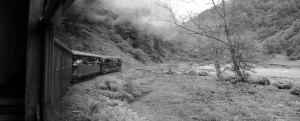Lisa Niver's Blog: We Said Go Travel, page 426
January 29, 2014
To be a Judge of Rio de Janeiro
 Rio de Janeiro. The city that has more love than Paris, more nightlight than Tokyo, more culture than Barcelona and more music than a New York City street. Rio is the city that only those willing to risk all will travel to, unless with a corporate credit card, business briefcase and a high luxury suite. Generally you’ll spend less here in a week than you will in a night in Paris and yet it’s the city that is so overlooked. But… price has nothing to do with it. Brazil has been in the spotlight over the last few years; of course there is the world cup next year and the summer olympics in 2016, but thats not all that hits the media. There’s the never ending bureaucracy between the police and government officials which influence heavily publicised riots that demonstrate to onlookers a constant fear of ‘danger’, so naturally its a place where only the bravest of travellers will attempt to step foot, at least at this time. So why would anyone come here? Sure theres beaches, the brazilian booties, and the World Wonder ‘Cristo Redeemer’, but what really is the purpose in coming to a city for no other reason but to see a giant statue and take a picture imitating his stance?
Rio de Janeiro. The city that has more love than Paris, more nightlight than Tokyo, more culture than Barcelona and more music than a New York City street. Rio is the city that only those willing to risk all will travel to, unless with a corporate credit card, business briefcase and a high luxury suite. Generally you’ll spend less here in a week than you will in a night in Paris and yet it’s the city that is so overlooked. But… price has nothing to do with it. Brazil has been in the spotlight over the last few years; of course there is the world cup next year and the summer olympics in 2016, but thats not all that hits the media. There’s the never ending bureaucracy between the police and government officials which influence heavily publicised riots that demonstrate to onlookers a constant fear of ‘danger’, so naturally its a place where only the bravest of travellers will attempt to step foot, at least at this time. So why would anyone come here? Sure theres beaches, the brazilian booties, and the World Wonder ‘Cristo Redeemer’, but what really is the purpose in coming to a city for no other reason but to see a giant statue and take a picture imitating his stance?
So then, why did I come to Rio?
To be honest, I wanted to travel through South America, and the cheapest flight I could find was into Rio de Janeiro. Even coming from the travel industry I knew nothing about Rio, I knew nothing about the customs, the culture, the food. I didn’t even know what Lapa was until I heard it mentioned a few times whilst here and then googled it, let alone Copacabana, Ipanema and the structure of the city physically. I was then surprised to see that the city itself, it actually a huge beach, surrounded by beautiful green mountains and a few (thousand) high rise flats in-between. Throw in a couple of lakes and basically you’ve got Rio- a natural paradise. At a glance I started to understand the hype. Well, theres the beach, and the weather is generally nice, and I’m a beach lover so it was a nice change from other cities. But, it was more than just a horizon of translucent blue/green water that got me. It was more than the view from the top of a mountain, it was more than the reflections of light on one of the many lakes after the sun set. Personally, I am not one to be attracted physically. In fact, Im the kind of person that after a typical ‘laugh at me, smile at me, twinkle in my eye’ kind of philosophical conversation, I’ll then start to think about the attractiveness, and Rio, well… Lets just say it has a whole lot more than a twinkle and some good banter.
Rio is like the jewel I accidentally stuck to my wallet with mismanaged superglue, but instead of tediously trying to rip it off like a bandaid, I decided to embrace it and make it a part of the patchwork. Call it edgy, call it hipster, but hey; Rio managed to become a part of me. Heres a quick confession: I’ve been in Rio for 6 months now, and I have never seem ‘Cristo Redeemer’ up close. I didn’t come to Rio to tick of a list, and I didn’t decide to stay here to have bragging rights. In fact, I stayed because I actually couldn’t rid myself of the addiction that is Rio de Janeiro. I tried to leave Rio, many times, but always wound up feeling more homesick than I ever have. Apart from chocolate and a nice glass (or three) -hmm actually or seven glasses of red, Rio is the only drug I need. It’s a vicious circle, like all drugs because the longer I stay, the more I never, ever, ever want to leave.
So theres the whole danger aspect that you read about, and I have read about a lot. Before arriving my mother was horrified that I was going to Brazil, and South America in general. Mosquitos that kill you, riots with tear gas and rubber bullets, rapes, kidnappings. Basically she did what she could to find every single story that would mean my demise. But thats the thing about the media, you only hear the bad things. One rape (horrible as it may be), by one insane person is detrimental to an entire society. But with that in mind I was of course wary and cautious upon arrival. Maybe I am just the lucky one, because never have I ever felt any danger whilst walking the streets of Rio de Janeiro, daytime, nighttime, through the city centre or through a favela. I have felt much more danger walking around Barcelona in the middle of the day. Sure there are stories, and sure, bad things happen, just like anywhere else in the world, but living in Australia meant that I was confronted with many natural and unnatural disasters; bush fires, cyclones, droughts, and then the occasional street shooting or body that wound up cut into 70 pieces in a garbage bin. In the United States it seems that every month there is one crazy guy with a machine gun or a machete that ends up attacking a school filled with innocent children. And not to mention the child abuse and abuse against women that happens behind closed doors in many other of the worlds nations. But when something as trivial as losing my wallet in Rio, and once I finally accepted the fact that it was gone and that everything can be replaced, I got a phone call saying that it had been handed in. I am the lucky one, of course, and of course this won’t happen to everyone, but to get a wallet back with every single cent left inside- all I am saying is don’t be to abrupt to judge everything you hear or read about.
My experience in Rio has been nothing short of incredible, fantastic, mind blowing, life changing, amazing. I have never experienced a culture where most locals can’t take trips for too long because they miss their home city, and to meet other foreigners who get stuck, just as I did, it really says something about the city. But maybe it also says something about the type of travellers who dare to step foot here. For me though, through good and bad, thick and thin, all that ’til death do us part kind of junk, it seems that I have found home, in a seemingly hopeless place.
The post To be a Judge of Rio de Janeiro appeared first on We Said Go Travel.
France: Café au lait
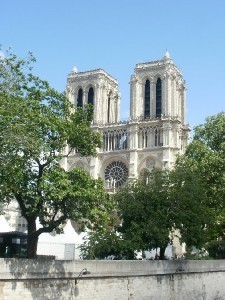 “Café au lait?” asked the square, solid waitress in our Paris pensionne.
“Café au lait?” asked the square, solid waitress in our Paris pensionne.
“No, my wife won’t be coming down this morning” replied the American, firmly, trying to convey he understood what he was being asked, when clearly he didn’t.
“Pardon, monsieur, café au lait?” repeated the puzzled waitress.
“Yes, she was the one wearing a fur coat yesterday” he uttered more confidently as the waitress looked more and more lost. “She’s not feeling well and thinks she’ll leave breakfast for today”.
The waitress looked around the breakfast room; this was a situation she was unfamiliar with. Usually she got a simple oui s’il-vous-plait or non merci. As the American pointed to another table’s café au lait and made signs indicating he would like the same she looked at him as if he was deranged and abruptly left the room, returning moments later to dump the cup and saucer down on the table with none of the friendly ceremony she normally showed.
My friend and I continued to sip our coffee and nibble our croissants, congratulating ourselves on our rudimentary French. In Paris on a week’s package holiday from London we were determined to see as much as we could, despite the November cold. Every morning we would eat our breakfast then set out to conquer the sights of Paris.
Young and fresh from New Zealand we were ignorant of many European customs. When visiting the Cathedral of Notre Dame we decided to take the tour of the belfry, giggling and imaging Quasimodo at every turn. The tour group followed the guide around, enjoying his banter and laughing at his jokes. As we left he stood outside with his hand out. Completely ignorant of tipping my friend enthusiastically shook his hand and thanked him for a wonderful tour. We couldn’t understand it when the guide glared at us and muttered something under his breath.
Walking in Les Tuileries one day we were approached by a group of camera laden Japanese. They stopped us and with much gesticulating indicated they wanted to take our photo. We tried, oh how we tried, in English and French and then loud English and French, to tell them we weren’t French but to no avail; perhaps my beret didn’t help. After lots of posing and snapping they bowed and waved us off.
The Eiffel Tower, Notre Dame, the Champs Elysees, the Seine, we loved it all. We visited the Louvre and trying to see as much as possible, came out happy but with our heads spinning. A show at Moulin Rouge was beyond our budget but we strolled the streets of Montmartre one evening and returned to visit Sacre Coeur the next day.
We stood by the tomb of the Unknown Soldier in the Arc de Triomphe before climbing to the top and getting an aerial view of the frenetic motoring around the Arc. We visited Napoleon’s tomb in Les Invalides and marvelled at the ambition of the little General, his militaristic ability and legacy to Paris.
One day we took the train out to Versailles and wandered around, bemused by the extravagance of the infamous Marie Antoinette and the total power and arrogance the French royal family had enjoyed.
We bumbled through that week, enjoying the ambiance: the people, the food, the famous sights, loving everything about Paris. We came away determined to return.
I’ve returned to Paris several times and its appeal has never dimmed. I’ve arrived at Paris by train, plane and bus but still get a thrill when alighting on her streets.
I’ve visited in autumn, winter and spring. It’s been hot, cold, wet and dry. I’ve been there with friends, my mother, my husband and children and my daughter. I’ve stayed in pensionnes, hotels and apartments. I’ve been for hours, days and weeks.
I’ve been hassled endlessly by street vendor at tourist sites, conned strolling along the Seine, my daughter was nearly robbed in McDonalds on Les Champs Elysees and my sister was mugged in the Metro but still its allure remains.
I’ve stood in crowds waiting to go into art galleries, perched on tiptoe to see the Mona Lisa, been swamped by other tourists at the Eiffel Tower but still managed to find a quiet spot to sit and watch Paris life passing by.
I always find a new park to roam in, another art work to stand and gaze at, some new food to try or another aspect of Paris life to enjoy.
I’ve always left determined to return and return I will, soon I hope.
About the Author: Clare Gleeson is a New Zealand historian, librarian and travel writer who enjoys exploring her own country as well as those further afield.
Thank you for reading and commenting. Please enter our next Travel Writing competition and tell your story.
The post France: Café au lait appeared first on We Said Go Travel.
January 28, 2014
No Regrets in Romania
This might seem an anti-travel manifesto at first. It’s not. I can assure you that I am as wild, free, and wanderlust as one gets. However, we all need stability at one point. And like all the elements gathered here, contrasting and somewhat antagonistic, I have to confess that I’m living in and craving for two worlds: serenity and peace vs. turmoil and hecticness. Sometimes, and it might get even stranger, I need that extra dash of adrenalin, to make me aware (once again!) of how life should be lived to the full, in my humble attempt to be happy 100%.
Isn’t happiness topping every wish list of every human in every corner of the world? Disguised in different forms, it’s true, and a result of several factors. Could places be one of those factors? They sure are!
In my search for happiness through my travels, I did find those places that give me what I seek. Trying to reach that perfect balance between serenity and hecticness, I sometimes joke that I would like to teleport to Scotland every single day, to get the supply of positivity and good vibes that the people in this magical land could provide. This goes hand in hand with the mind-soothing powers of the landforms there, where every stone and every castle seem to tell a story and to have their own history.
For the adventure, I turn to Bosnia. To the inspiring nature there – mysterious yet incredibly welcoming –, to the rivers that have no equal, and to the incredible people – resilient and immensely kind despite going through the difficulties of a war they did not ask for. They are for me a constant reminder and drive to seize the day and fulfill my dreams.
For the hecticness and for everything else, I have my home: Romania. Overlooked by many travellers, adored by others, and probably stacked in a ‘former Communist curiosity’ file by some, it is enchanting in my eyes. Not only because it is my country, but because she is worth it. Only a few countries in the world provide such diversity in terms of nature, culture, and entertainment. We seem to be having it all – from majestic mountains to lost wetland canals, from time-forgotten fortresses to architectural curiosities, from adventure parks to trendy high-street clubs. And yes, from corrupt politicians, bad roads, crazy traffic to too laid back people and petty crime.
I clearly started my post-teenage years by greatly disliking some of these aspects, but something shifted on the way and I started loving even the bad things in my homeland. As I always say, isn’t this the way one should love a place – in its entirety? I like living in Romania! This is why I returned from Scotland, this is why I come back home after each and every travel. I miss the rhythm of my life here – always on the go, constantly on the run, and usually lacking time. I miss standing in line for or struggling to get official papers from public institutions. I miss the holidays, when most of us – Romanians – complain that we don’t have enough money, yet our shopping carts are overflowing with food, drinks, and presents.
And I miss those moments when we remember how patriotic we are, how proud we are to be Romanians, how hospitable we are and that – like Dorothy says – there’s no place like home. In the end, what I like and miss most when travelling is travelling back to Romania at the end of my voyages to other destinations and discovering her more attractive than ever, faults included.
About the Author: Marcel Băncilă is a history postgraduate student and experienced traveller, always thirsty for adventure.
I travel the world to discover its hidden treasures, I dream to get to the historical sites I’ve only explored in books, and I hope to make a difference through my work and vision of the world around me. Please follow me at my blog! Photo © Marcel Băncilă
Thank you for reading and commenting. Please enter our next Travel Writing competition and tell your story.
The post No Regrets in Romania appeared first on We Said Go Travel.
Gratitude Travel Writing Contest Winners 2013
Thank you to all the writers who participated in our 2013 Gratitude Travel Writing Contest!
Two hundred and eighty-nine writers from thirty-eight nations participated to write about one hundred and two countries for our contest!
Click here to read all the entries.
AND THE WINNERS ARE:
 Our First Place Winner is Michael MacKenzie from Australia. Enjoy his article about Morocco, “Why does Abdul live in the desert?“
Our First Place Winner is Michael MacKenzie from Australia. Enjoy his article about Morocco, “Why does Abdul live in the desert?“
Our Second Place Winner is Lisa Gabrielson from Bethesda, Maryland, USA. Enjoy her article about Paris, “A Meditation on Paris.”
Our Third Place Winner is Sherrydayne Edwards from Australia. Enjoy her article about Rio, “How Not to Fall in Love with Rio de Janeiro.”
Honorable Mention:
Hannah Thompson-Yates “Behind the Taj”
Bridgett Cockrell: “We are all Handicapped”
Nicola Desouza: “Water-Borne Love in Varanasi“
WATCH: The Google Hangout Announcement
We really appreciate everyone who shared, tweeted, promoted and participated in our 2013 Travel Writing Contests. Thank you to Jessie Voigts and Wandering Educators for hosting our hangout!
We hope you will join in our Inspiration Travel Writing Contest: First prize: $1,000usd; enter until February 14, 2014.
We look forward to reading more of your stories in our next contest! Credly Badges will be arriving soon for all writers and winners!
Thank you to our esteemed judges!
Richard Bangs, the father of modern adventure travel, is a pioneer in travel that makes a difference, travel with a purpose. He has spent 30 years as an explorer and communicator, and along the way led first descents of 35 rivers around the globe, he is currently producing and hosting the new PBS series, Richard Bangs: Adventure Without End
Tiffany Hawk, is a former flight attendant and the author of Love Me Anyway, a darkly funny novel about life at 35,000 feet. She has an MFA in creative writing from UC Riverside and her work can be seen in such places as The New York Times, The Los Angeles Times, National Geographic Traveler, and NPR’s “All Things Considered.” Join Tiffany Hawk for the complete roadmap to exotic travel writing: Travel Writing Road Map.
Congratulations to our winners! Thank you to everyone who participated!
The post Gratitude Travel Writing Contest Winners 2013 appeared first on We Said Go Travel.
Wine Country Arizona
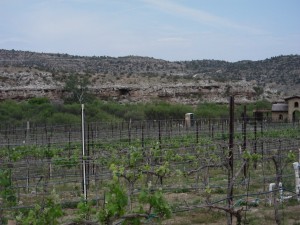 The terms inspire all the senses. You expect to stand at vast rows of grapes and see them make their way over green, or maybe golden, hills. In the most distance horizon, you may see a mountain top barely discernible under a misty cloud. There can be a chill in the air or warm sun rays on your back. You can practically taste the lush fruit ready for harvest. Sometimes you hear live music or remember a great meal; it can be a party or an introspective time. You visualize charming structures in the landscape. You may even recall passionate business owners anxious to colorfully describe the tastes resulting from, literally, the fruits of their labor. You likely did not think of the desert state of Arizona.
The terms inspire all the senses. You expect to stand at vast rows of grapes and see them make their way over green, or maybe golden, hills. In the most distance horizon, you may see a mountain top barely discernible under a misty cloud. There can be a chill in the air or warm sun rays on your back. You can practically taste the lush fruit ready for harvest. Sometimes you hear live music or remember a great meal; it can be a party or an introspective time. You visualize charming structures in the landscape. You may even recall passionate business owners anxious to colorfully describe the tastes resulting from, literally, the fruits of their labor. You likely did not think of the desert state of Arizona.
It’s ok if you didn’t, I didn’t either. This is a lesson about taking the time to dig a little deeper when you travel. The natural splendor of the Grand Canyon, Sedona and Oak Creek Canyon are unsurpassed and draw the highest numbers of tourists to the state each year. It is protected National Forest and State land. It’s #9 on the Lonely Planet’s top 10 US travel destinations for 2013 and one of top in the United States each year. Verde Valley is the land of ancient peoples and now has over 40 wineries operating in the region.
The original Arizonans considered this area sacred. There is evidence of human presence in the Verde Valley as early as 4000 BCE. Two rare, natural, perennial streams, Verde River and Oak Creek, meet in this valley. As the original Arizonans knew, water is essential to life. Verde Valley provided them reliable water, abundant wildlife, and fertile soil. The valley walls provided shelter and distant views. The Hohokam are credited with developing irrigation canals for farming. The Sinagua (which means “without water”) designed cliff-dwelling masonry building techniques and successfully intermingled with the Hohokam. The petroglyphs revealing stories of these shared experiences are visible on the rocks today. It is believed the Southern Sinagua left the area in the 1400’s perhaps due to conflict with the Yavapai. The Yavapai remained until 1582 when the Spanish invaded the area.
So how has this ancient site evolved into a grape growing region? Grapes, after all, are an agricultural product and if the Hohokam could farm thousands of years ago, then why not today? If those “without water” can thrive, why not new agriculture? Any viticulturist will tell you that stressing grape vines makes for better fruit. This is a Semi-arid, steppe climate with warm, sun-drenched days and cool evening temperatures. The alluvial soils are deep, well-drained, alkaline soils with a good balance of both clay and sandy loams. The rivers merge together at latitude 34°N. Most famed wine growing regions of the world reside between 30 and 50 latitude in both hemispheres. Consider the regions of Palermo or Naples, Italy; Adelaide Hills, Australia; Andalusia, Spain; Napa/Sonoma, CA; Mendoza, Argentina, Bordeux or Champagne, France. Grapes like all these growing environments.
The picturesque nutmeg and cinnamon colored soil of Sedona transitioned to grey as we drove southwesterly along Highway 89A into Cottonwood, AZ. This is just one of the historic towns in the region. Most of them were built because of the land; the mining industry grew quite prosperous. Ironically, this area was the bootleg capital of Arizona during prohibition and now hosts several tasting rooms for the local wineries. The wineries are producing award-winning wines. The land, and the weather conditions, still determine the harvest each year.
The sun was lowering in the sky by the time we arrived at Alcantara Vineyards & Winery. It was the closest we had been to grapes all day. They did, in fact, march their way towards the horizon, row by row, up the ancient hills to the tops of the surrounding mesas and down towards the river bank. We sat on the tasting room’s deck, above the rivers. Looking across them, we could see the ancient cliff dwellings high above the river’s confluence. We had the opportunity to visit with the Proprietress, Barbara Predmore. She spoke passionately about loving life, living well, and wine. She told us of embracing the land and respecting the life-sustaining water of the rivers.
One of my favorite sayings about wine is an old French proverb that is written, “In water one sees one’s own face; but in wine one beholds the heart of another.” Barbara may not have Sinagua, or Hohokam in her blood, but she had clearly channeled the ancient farmers. It was while listening to her heart speak that I realized how perfect this day had been. I, too, felt connected to this beautiful, ancient land. Wine Country – Arizona, I get it now.
About the Author: Kathleen Rich is a travel enthusiast who writes about great places to try food & wine around the globe.
Thank you for reading and commenting. Please enter our next Travel Writing competition and tell your story.
The post Wine Country Arizona appeared first on We Said Go Travel.
Balinese Smile
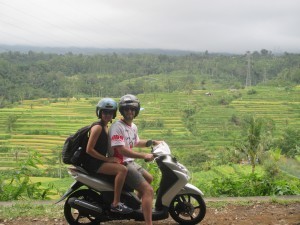 They crept up the path holding one hundred pound sacks of rice on their heads, dark forearms glistening in the late afternoon sun. The elderly man approached first, maneuvering around the two motorbikes we had parked on the hill’s gravelly shoulder. The two women followed, eyeing us curiously.
They crept up the path holding one hundred pound sacks of rice on their heads, dark forearms glistening in the late afternoon sun. The elderly man approached first, maneuvering around the two motorbikes we had parked on the hill’s gravelly shoulder. The two women followed, eyeing us curiously.
I removed my backpack and stretched my arms to the sky. After three hours of riding my shins were layered with motor oil and the arches of my feet pulsed from the bike’s metal pegs. The road was silent but for the occasional whizzing motorist, the sun’s intensity lessened by the cooling mountain air. I stared in awe at the Technicolor fields spread before me, the tiny figures in straw Chinamen hats crouching and pulling, sifting and packing their way along terraced rice paddies.
The rice sacks thumped to the ground, rousing dust at our feet.
“Lake Batur?”
It was a question we had asked dozens of strangers over the past several hours. With nothing but a map of main arteries and two roaring bikes we rented for six dollars a day, we had hit the open road, weaving through the tourist choked veins of New Year’s in Ubud, Bali. We had bumped along gravel, squeezed between cars and motorbikes and curb-less drop-offs, played chicken with oncoming traffic, and wound our way up curves and mountain bends until we were nearly the only foreigners – at times the only people – on the road. Every ten or fifteen minutes our friend sought guidance, shouting out the next major road on the map, roads that would eventually lead to the volcanic northern landscape of Lake Batur.
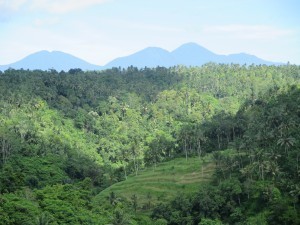 The Balinese people went out of their way to assist us. More than once, a helpful stranger took the time to lead us through a tricky turn or congested six-lane roundabout, either by hopping out of their store and onto a motorbike or rerouting themselves out of their own way. Other times they drew maps or enthusiastically flagged us in the right direction as we buzzed past.
The Balinese people went out of their way to assist us. More than once, a helpful stranger took the time to lead us through a tricky turn or congested six-lane roundabout, either by hopping out of their store and onto a motorbike or rerouting themselves out of their own way. Other times they drew maps or enthusiastically flagged us in the right direction as we buzzed past.
“That way!”
“Wrong way!”
“Back there, go left!”
The strangers never asked for anything in return, and not one of them balked at our request for help.
The man moved one rice sack onto the back of a motorbike – no small feat – and stepped toward us. His clothes were tattered and faded and he was missing his front teeth. He spoke little English, but understood enough to tell us we were heading in the right direction.
“There,” he said. He motioned down the narrow dirt path he had arrived from. His face, leathery and deeply etched, broke into a soft, easy smile. He nodded his head in a way that told us to proceed forward. Please, the nod said, take a look at my land. Take a look at the beauty.
The Bali landscape is beautiful, yes. Breathtaking. Best-in-class. But I quickly discovered that – for me – the true power and beauty of the island lied in its people.
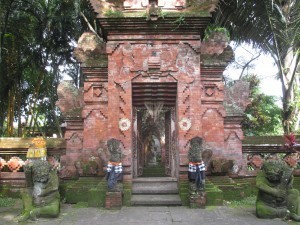 Known as the Land of Gods, the Hindu people of Bali are a most devout people, dedicating much of their daily lives to rites and ceremonies aimed at maintaining harmony in the world. Morning and night offerings were made to the gods, most visibly through banana leaf boxes inside of which existed pink and red and yellow flowers and, interestingly, a few teddy grams or candy drops. (“Food for my God”, explained one Balinese woman, when I questioned her about the teddy grams.) Incense burned often and the island itself smelled pervasively of lime and floral sweetness. In Hindu religion the entryway or gate is sacred; nearly every doorway in Ubud was like a beautiful hand-crafted work of art, resplendent with intricate carvings and elephant sculptures. Hindu homes, one taxi driver explained to me, had a temple for their god; I could see such temples over the outward stone gate of home villages, gold domes reflecting the sun.
Known as the Land of Gods, the Hindu people of Bali are a most devout people, dedicating much of their daily lives to rites and ceremonies aimed at maintaining harmony in the world. Morning and night offerings were made to the gods, most visibly through banana leaf boxes inside of which existed pink and red and yellow flowers and, interestingly, a few teddy grams or candy drops. (“Food for my God”, explained one Balinese woman, when I questioned her about the teddy grams.) Incense burned often and the island itself smelled pervasively of lime and floral sweetness. In Hindu religion the entryway or gate is sacred; nearly every doorway in Ubud was like a beautiful hand-crafted work of art, resplendent with intricate carvings and elephant sculptures. Hindu homes, one taxi driver explained to me, had a temple for their god; I could see such temples over the outward stone gate of home villages, gold domes reflecting the sun.
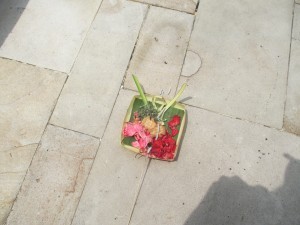 If I had a picture of every face we met during our two-day, eight-hour-a-day motorbike excursion, every face at the moment we pulled away, or the moment I looked back, which was often, the reel would consist of one hundred something smiles. From men in brightly colored headbands tied at the center of their foreheads to the women and children in the shade of roadside stands, the Balinese smile is the greatest gift I took with me, the purest reminder of happiness from a most respectful, humble people.
If I had a picture of every face we met during our two-day, eight-hour-a-day motorbike excursion, every face at the moment we pulled away, or the moment I looked back, which was often, the reel would consist of one hundred something smiles. From men in brightly colored headbands tied at the center of their foreheads to the women and children in the shade of roadside stands, the Balinese smile is the greatest gift I took with me, the purest reminder of happiness from a most respectful, humble people.
The post Balinese Smile appeared first on We Said Go Travel.
Time Moves On in Alaska
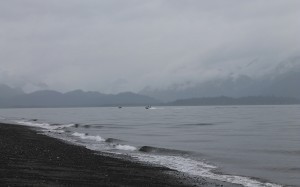 Alaska, a cold, unforgiving frontier perched high on the globe, where the sun slides across the sky more slowly. I was intrigued by this place, so different from anywhere I had ever visited. I had no idea what to expect as I stepped off the plane and onto the chilly tarmac. That night as I looked out my window at the river behind my hotel in Anchorage, where a man was still salmon fishing in the light of the sun, I could tell that this was going to be a different kind of trip.
Alaska, a cold, unforgiving frontier perched high on the globe, where the sun slides across the sky more slowly. I was intrigued by this place, so different from anywhere I had ever visited. I had no idea what to expect as I stepped off the plane and onto the chilly tarmac. That night as I looked out my window at the river behind my hotel in Anchorage, where a man was still salmon fishing in the light of the sun, I could tell that this was going to be a different kind of trip.
The next morning we got up surprisingly early, to catch the train to Denali. Inside our hotel room, black out curtains drawn, my friends and I were slow moving and tired. All we needed was to step out the door and, bam! The sun greeted us, like it was high noon instead of four in the morning.
With the sun shining down on me I felt rejuvenated. I was on Alaskan time now, and I never wanted to go back. With our new burst of energy we made our way through the biting wind to the railroad and boarded our glass top train, ready for the next leg of our adventure to begin. We trundled along on the scenic route, surrounded by tall green trees, beautiful blue lakes, and wildlife popping out of every nook and cranny, time seemed to shift again. The slow swaying of the train car, coupled with the lazy stare of a moose, and the friendly smiles of the staff slowed everything down. The bustle of the early morning became a lazy stroll, like the swaying of a hammock in a tropical breeze.
Our train ride did come to an end, and we were deposited at our new hotel at the mouth of Denali National Park. Beauty and splendor was right outside our door. Hiking, river rafting, birdwatching, anything you could dream up was just a bus ride away. It was breathtaking, with more wildlife than you could ever hope to see and spectacular views of the mountain range that gave the park it’s name. Week one flew by in a flurry of activities, and soon we reboarded our glass top train back to Anchorage.
As we stepped back into the same hotel room we spent the first night in, I felt changed, in tune with the Earth. Denali’s trees had spoken to me and I felt the wilderness calling to me once more. After a week of activity, spending the week in a city seemed somehow wrong. So, we quickly repacked our bags, rented a car, and with some spectacular advice from a hotel employee, started our next adventure.
It was time for some spontaneity. After a few hours travel we stopped at a local diner packed with as much character and quirky salt and pepper shakers as humanly possible. A friendly waitress there gave us directions to the bridge down a dirt road where we could see the bright red salmon in their spawning grounds. This experience proved once again that there are two things that Alaska has no shortage of, friendly people and wildlife.
As we made our way back to the main road, I knew there was no way this trip could ever get any better, so I did my best to freeze this moment, but as time so often does, it moved on. Soon we found ourselves driving out onto a sliver of land, barely wider than the road, called Homer’s Spit. As I looked around at the kitchy shops of this fishing village on stilts I had to wonder if we were at the right place, but another friendly local with a toothless grin soon lead us to a pathway which took us beyond the row of shops.
Here as I stood on the black pebbled beach, where the water stretched as far as the eye could see, and the ground seemed to be made of shards of black onyx, it happened. Time stopped. It may have kept moving for the rest of the world. But for me, in that moment, the sheer beauty of the glassy water and the cool breeze proved to me that time can stand still.
The spell was eventually broken by a playful otter, but that one moment will stay with me forever. In a way, that moment continues on, and as I carry that experience with me it will always remind me that the time I have on this Earth is precious and sometimes the risk of the unknown is what will lead to the happiness that you seek.
About the Author: Katie Manzano has been traveling her entire life, with cross country trips every summer as she grew up with her family. Her favorite places to travel are National parks in an Airstream trailer.
Thank you for reading and commenting. Please enter our next Travel Writing competition and tell your story.
The post Time Moves On in Alaska appeared first on We Said Go Travel.
January 27, 2014
Join us Live: Winners of Gratitude Travel Writing Contest Announced!
 Join us for a live announcement of the 2013 winners of the Gratitude Travel Writing Contest! Direct link to the hangout click here.
Join us for a live announcement of the 2013 winners of the Gratitude Travel Writing Contest! Direct link to the hangout click here.The Judges, Richard Bangs and Tiffany Hawk, will be live from California and Virginia. Lisa Niver Rajna and George Rajna, founders of We Said Go Travel and authors of Traveling in Sin, will be live from Koh Samui, Thailand.
Hosted by Dr. Jessie Voigts of Wandering Educators and the Teen Travel Blogging Mentorship Program.
Thank you for participating! Over 500 writers from over 50 countries have shared their stories in our three travel writing contests in 2013.
The Google Hangout announcement will be live Jan 28 at 6pm in California, 9pm in New York City and Jan 29 at 9am in Koh Samui, Thailand. If you cannot make it, it will be archived on YouTube and we will add the link here and on our Facebook page. Click here to join the hangout.
The Inspiration Travel Writing Contest is open! Enter by February 14, 2014. First Prize is $1,000usd. We hope to announce YOUR NAME as the winner of our next contest!
Winners of the We Said Go Travel Writing Contests:
Summer 2103 Independence Travel Writing Contest:
Our First Place Winner is Jillian Gotfredson who was born in South Korea but grew up in Kansas City, Missouri. Enjoy her article, “Myanmar, Ferry Mothers.”
Our Second Place Winner is CC Xander who is one of America’s elite tennis coaches and travelers. Enjoy his article, “Tulum, Mexico.”
Our Third Place Winner is Esther K. Meyers who born in a DP camp at the close of the war to holocaust survivor parents. Enjoy her article , “Poland: The Magic of Discovering Legacy.”
Honorable Mention:
Fatimah Abdulmalik “Shackles Released in Sudan“
Chris Palmer: “Tanzania: Freedom in Motion”
Asia and Russell Nichols: “Indonesia: Wooden Pole in the Village“
Winter 2013 Inspiration Travel Writing Contest:
Our First Place Winner is Rachel Zimmerman Brachman who was born in Canada but now lives in the USA. Enjoy her article about Alaska, “The Whale and the Trampoline”
Our Second Place Winner is Jillian Gotfredson who was born in South Korea but grew up in Kansas City, Missouri. Enjoy her article about Thailand, “Finding Friendship and Tea Above the Clouds.”
Our Facebook Vagabond Choice Award Winner is Arjun Karunwho is from India and wrote about India in a post called, “Kochi and New Year.”
The post Join us Live: Winners of Gratitude Travel Writing Contest Announced! appeared first on We Said Go Travel.
Manzanilla, Trinidad: Island in an Island
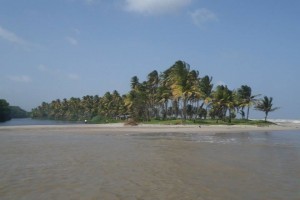 Come with me and join in our venture into ‘An island in an island’. My boyfriend and I decided to go on a road trip to discover the island of Trinidad located in the Caribbean Sea. The sun was warm and friendly as the people inhabiting the island. The air was cool and refreshing as her friends cool breezes and clean air accompanied her. We had our windows winded down to feel the breezes massage our faces with the pleasant scents from the green grass which raced in our nostrils.
Come with me and join in our venture into ‘An island in an island’. My boyfriend and I decided to go on a road trip to discover the island of Trinidad located in the Caribbean Sea. The sun was warm and friendly as the people inhabiting the island. The air was cool and refreshing as her friends cool breezes and clean air accompanied her. We had our windows winded down to feel the breezes massage our faces with the pleasant scents from the green grass which raced in our nostrils. Driving side by side, engulfed with such simple serenities in life, we were on our way to our own paradise beach in Manzanilla. Manzanilla beach is located along the eastern coast of the island and as we entered through the arches of coconut trees, we said goodbye to city life and hello to paradise.
The beach was like an island in our tropical island called Trinidad. Trinidad’s sister is called Tobago and therefore known as the islands of Trinidad and Tobago. We pulled to the side and as we opened the door, we were greeted instantaneously with the sensational sea breezes and a sight suited for the queen. The sun greeted us with the extension of her arms with warmth and hugs, an inviting feeling contagious for all there. The blue green waters were below us and in the near distance, we could see the island on the beach. It was surrounded by water yet its own. It had sands which were originally white and got a golden tan. The sands were tanned with lush green grasses covering the center of its surface, adorned with tall tropical coconut trees. The trees were nature at its best, streamed with perfection and outlined with greens from above. We stood there in awe. Time stopped for us to bathe in Manzanilla’s glory. We took one picture which etched its way in us forever and today we share this invaluable gift with you.
Mark and I have been dating for a year and embrace life with all her mysterious beauty. We couldn’t allow time to move forward without dissolving us, so Mark did what any man in his position would do, he looked into my eyes, held my hand and together, we jumped into the clear waters. Hand in hand we swam to the island and upon arrival, Mark went down on one knee. It was a fairy tale for we were on our own island, in a tropical paradise. We were engaged. It was a momentous occasion. Nature took us by her loving hands and joined us as one.
We made an unforgettable memory in Manzanilla and a tale to tell. You could join us with unforgettable experiences and making memories.
Myths of treasure islands fly through the air everyday, but we were blessed to breathe one. It was as though this beach proved that myths are real and that fairytales may actually come true. Relationships transform right before your very eyes and you appreciate the power of nature and her charms. She is quite charming. So come to Trinidad, jump in your car and see an island in an island.
About the Author: Therese sees life as a Blessing from God and embraces it with all her being. She believes that everything happens for a reason and that with God anything and everything are possible.
Thank you for reading and commenting. Please enter our next Travel Writing competition and tell your story.
The post Manzanilla, Trinidad: Island in an Island appeared first on We Said Go Travel.
Fix of Fantasy in Lofou, Cyprus
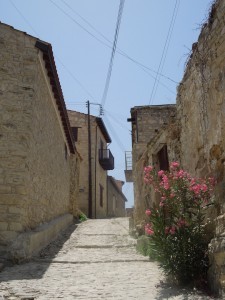 Two narrow roads, one easterly, the other westerly, wiggle their way from the main thoroughfares towards Lofou, an ancient Cypriot village ensconced between the hills northwest of Limassol. From either direction, the drive up evokes a welcoming sense of solitude. Grapevines, standing in line like obedient students, crowd the countryside and provide a stark contrast to the dearth of automobiles that share these same roads. Occasionally, a few mountain goats stumble onto the pavement and bleat at passersby. You expect to come across signs of inhabitation but for kilometers each sharp bend leads to another until you reach the entrance to the sleepy and isolated town.
Two narrow roads, one easterly, the other westerly, wiggle their way from the main thoroughfares towards Lofou, an ancient Cypriot village ensconced between the hills northwest of Limassol. From either direction, the drive up evokes a welcoming sense of solitude. Grapevines, standing in line like obedient students, crowd the countryside and provide a stark contrast to the dearth of automobiles that share these same roads. Occasionally, a few mountain goats stumble onto the pavement and bleat at passersby. You expect to come across signs of inhabitation but for kilometers each sharp bend leads to another until you reach the entrance to the sleepy and isolated town.
Built up in the clouds during the 14th century to fend off attacks from Arab raiders, Lofou, with its traditional carved yellow stone houses, ornate wooden doors and handful of residents, remains frozen in time. Walk up and down its cobblestone streets and minute alleyways during the summer months and the hustle and bustle of the island’s teeming beaches seems eons away. You peer into the empty courtyards of many of the well-preserved homes and picture a group of octogenarian women dressed like the night embroidering or kneading dough or sharing tales of their childhood. Children imagine Lofou as their own labyrinth, running and evading its narrow openings, tight turns and scattered olive and almond trees in the same way their favorite footballers dribble past stocky defenders. Old men, their paunches hanging over their waistbands, sit on rackety chairs outside the coffee shop and sip on muddy sweetened coffee. Often, you hear stones slamming down on backgammon boards followed by loud cackling and dejected cursing. And from the southernmost edge of town, you look down at the arresting and very real view of the Troodos foothills and lively Limassol communing with a glistening Mediterranean Sea.
In recent years, thanks to a push by the community to boost tourism in the area, Lofou has experienced a resurgence of sorts. Traditional boutique lodges like Apokryfo and Oinoessa, both rather sophisticated and henceforth pricy, and several taverns serving Cypriot delicacies have opened their doors to visitors. Each year, more and more of the village’s ramshackle homes are being revamped and transformed into idyllic weekend getaways for the urbanites. During the past three summers, Louvana Records, an independent Cypriot record label, has organized the Fengaros (“Moon”) Festival, a three-day event packed with performances and exhibitions by musicians, theater troupes, visual artists and stand-up comedians. Just last year, Greek rock legend Vasilis Papakonstantinou, who’s a dead ringer for The Muppets’ Sam The Eagle and draws hundreds of rabid fans to his concerts, headlined. Other local annual events sponsored by the Cooperative Credit Society of Ipsonas Lofou, the Ministry of Education and Culture and the Youth Board of Cyprus, among others, include a palouzes (basically, grape jelly) festival, tree-planting day, carnival party and Easter games.
Besides finding sufficient inspiration to—quoting Chilean author Roberto Bolaño—“write until night falls with the thunder of a thousand demons,” I have made it a goal of mine to own an artistic retreat in Lofou. There is something special about this remote mountain village imbued with serenity and idleness that inspires long hours of introspection. With its open skies, quiet days and nights, unencumbered nature and quaint rusticity, Lofou encompasses everything the writer in me needs to hopefully compose the next Great Cypriot-Ecuadorian novel. I fantasize about a modest two-story abode with a windowed nook looking out onto a patio bedecked with potted orchids and a centurial olive tree where to reflect on life and witness complex personas sprout from a blank screen. Albeit, my dear wife, a refined and intellectualized Cypriot beach bunny, already stresses over the likelihood of spending our holidays there twiddling her thumbs to the soundtrack of rustling leaves, birds chirping and my fingertips tapping on QWERTY like (Thomas) Mann possessed.
Until then, nonetheless, we’ll book the Palati studio at Oinoessa and load the station wagon to traverse—a lonely bend at a time—the Cypriot countryside for our monthly fix of fantasy in Lofou.
Originally from Ecuador, Mateo Jarrin Cuvi lives in Cyprus where he lectures in sociology, political science and anthropology. His writing has appeared in Cyprus Gourmet, The Financial Mirror, The Cyprus Dossier, as well as many other great publications.
Thank you for reading and commenting. Please enter our next Travel Writing competition and tell your story.
The post Fix of Fantasy in Lofou, Cyprus appeared first on We Said Go Travel.
We Said Go Travel
We Said Go Travel is a global community of over sixteen hundred writers with articles from every continent.
Stories are shared with photos and video from a perspective of the transformative power of travel. We Said Go Travel has hosted live and online events as well as travel writing contests around the world. ...more
- Lisa Niver's profile
- 57 followers





